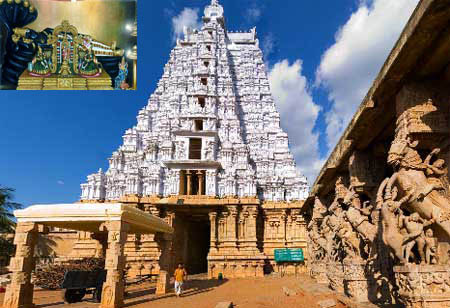|
|
Shrirangam

Name of the Temple |
- Śhrīrangam Śhri Raṅganāthaswāmi Temple.
|
Location |
|
| How to reach there? |
- By Air : Śhrīraṅgam Temple is located 15 km north from Thiruchirāppaḷḷi airport. Take the National Highway 38 to reach Śhrīraṅgam.
- By Train: Śhrīraṅgam Temple is located 9 km north from Thiruchirāppaḷḷi railway station.
- By Road: Thiruchirāpaḷḷi is well connected to various parts of Thamizh Nāḍu by the National Highway 38 from Thirucchi to Madhurai, 81 from Kāmāchipuram to Sethiathōppu and 83 from Thanjāvūr to Nagapaṭṭinam.
|
Rulers/builders and Time Period |
- The temple of Śhrī Raṅganāthaswāmi at Śhrīraṅgam boasts a historic past of great kingdom and a civilization thousands of years old. The temple belongs to the Chola, Pāndya, Hoysaḷa and Vijayanagar dynasties who successively swayed the destiny of the Tiruchirāpaḷḷi district. They range in the date between 9th and 16th century A.D. and are registered by the Ephigraphical society.
- The location where the Raṅganātha idol was placed was covered by an overgrowth of deep forests, due to disuse. After a very long time, a Chola king, chasing a parrot, accidentally found the idol. He then established the Raṅganāthaswāmi temple as one of the largest temple complexes in the world.
- According to historians, most dynasties that ruled the South—Cholas, Pāndyas, Hoysaḷas , Nāyakas—assisted with renovation and in the observance of the traditional customs. Even during periods of internal conflicts amongst these dynasties, utter importance was given to the safety and maintenance of temples.
- It is said that a Chola king presented the temple with a golden serpent couch. Some historians identify this king with Rājamahendra Chola, supposedly, the son of Rājendra Chola II. But it is of interest to note that he never figures in the latter's inscriptions, neither in the 4th year (that shows various members of the family going on rampage in different regions) nor in the 9th year (that shows only one member of the second generation).
|
Deity/Deities |
- Śhrī Raṅganāthaswāmi alias Viṣhṇu.
|
Architecture Style |
- The temple of Śhrīraṅgam is situated at 10 degrees 52’N and 78 degrees 42’ E towards the southern tip of India on an island formed by two arms of the River Cauvery.
- The temple covers a vast area of about 6, 31, 000 Sq. m (156 Acres).
- The temple consists of seven concentric rectangular enclosures round the sanctum sanctorum.
- The gopuras of the seventh enclosure are unfinished. They are called Rājagopurams. The impressive dimensions of their bases prove that when finished, they would have risen to a height of at least 50m. The third enclosure has the Kārthikai gopuram, leading to the Garuḍa Manṭapa, which consists of 14 rows and it is the most beautiful Manṭapa in the Temple.
- In the western wing, kitchens and rice storehouses are found. The first enclosure to which, like the second, there is only one entry, by a gate in its southern part; the Nāzhikeṭṭān Gopura, on either side has images called Śhankhanidhi and Padhmanidhi, the conch and the lotus respectively, which are the attributes of Viṣhṇu.
- To the southwest, storerooms have been fitted up. Large mirrors have been placed in the corners to reflect the statue of the god when it issues from the sanctum.
- The hall of 1000 pillars is the most awesome part of the Śhrī Raṅganāthaswāmi temple/Śhrīraṅgam temple.
- This temple is constructed in the Dravidian style of architecture.
|
Special Reference to Fine Arts |
- Kambar is a 12th century Tamil poet who composed Kamba Rāmāyaṇam , a work inspired from the epic, Vālmīki Rāmāyaṇa . To get the approval of his work from scholars he came over to the temple. The Jain scholar Thirunarungundam honoured the work and it resulted in Tamil and Sanskrit scholars approving the work. The open hall where he recited his verse lies close to the Raṅganāyaki shrine within the temple.
- Rāmānuja, the leading expounder of Viśhiṣhṭādvaita , during his stay in Śhrīraṅgam, he is said of have written "Gadhya Thrayam", which is recited in the temple during the ninth day (Panguni Uttaram) of the festival of Adi brahmotsavam. His Thirumeni (the symbolic body) is preserved and offered prayers even today after 8 centuries.
|
Other References |
- Śhrīraṅga Mahāthmīyam is the compilation of the religious accounts of the temple, detailing the origins of its greatness. According to it, Brahmā, the Hindhu God of creation was once in a state of deep meditation and in His supreme trance received the gift of the Viṣhṇu's idol, "Ranga Vimāna".
- He was told by god that there would be seven other appearances of such idols on earth – Śhrīraṅgam, Śhrīmuṣhṇam, Venkatādhri (Thirumala), Sāligrām (Mukthināth), Naimiṣhāraṇya, Thoṭādhri, Puṣhkara and Badrināth.
- The idol was then passed on by Brahma to Viraja, Vaivaswatha, Manu, Ikṣhwāku and finally to Rāma. Rāma, himself an Avathāra of Viṣhṇu, worshipped the idol for a long time and when he returned victoriously from Śhrī Lankā after destroying Rāvaṇa, he gave it to King Vibhīṣhaṇa as a token of appreciation for the latter's support for Rama against his own brother, Rāvaṇa.
- When Vibhīṣhaṇa was going via what is currently called Trichy en route to Śhrī Lanka, the deity wanted to stay in Śhrīraṅgam, captivated by the devotion of a King called Dharma Varma, who was doing penance to have the Lord to permanently stay at Śhrīraṅgam.
- Śhrī Raṅganāthaswāmi stayed put there, promising to cast his benign glance eternally on Śhrī Lankā. Hence it is that the deity (in a reclining posture) faces South.
|
Other Special Remarks |
- Śhrīraṅgam temple is considered the first and foremost of all the 108 temples.
- Periyāḷvār begins the description of Śhrīraṅgam with two purāṇic stories according to which Kriṣhṇa restored to life the son of his guru Sāndīpini and the children of a Brahmin .
|
Special Reference to Performing Arts:
|
- Religious documentation details this temple as the only one of its kind for Viṣhṇu that was sung in praise by all the Āzhwārs (Divine saints of the Tamil Bhakthi movement), having a total of 247 pāsurams (divine hymns) in its name. Āchāryas ( guru ) of all schools of thought – Adhvaitha , Viśhiṣṭādhvaitha and Dhvaitha recognize the immense significance this temple, regardless of their affiliation.
- Nālāyira Dhivya Prabhandam is a collection of 4000 hymns sung by 12 āzhwars saints spread over 300 years (from late 6th to 9th century A.D.) and collected by Nāthamuni (910–990 A.D.). Dhivya Desams refer to 108 Viṣhṇu temples that are mentioned in Nālāyira Dhivya Prabandham.
- Thondaradippodi Āzhvār and Thiruppāna Āzhvār have sung exclusively on Raṅganātha. Āndāḷ attained Śhrīraṅganātha on completion of her Thiruppāvai (a composition of 30 verses) in Śhrīraṅgam. Of the 4000 Pāsurams there are 247 hymns dedicated to the deity of this temple. Except Madhurakavi Āzhwār , all the other eleven Āzhwārs have created Maṅgalaśhāsanam (praise) about the Ranganāthar in Śhrīraṅgam.
- Ādhi Śhankarāchārya’s - Śhrī Raṅganāthāṣhṭakam, Vedhāntha Deśhika ’s - Pādhukā Sahasram, Bhagavaddhyāna Sopānam & Abhīthi Sthavam, Śhrī Paraśhara Bhattar’s - Raṅgarāja Sthavam and Guṇarathnakośham, Kūrathāzhwar’s - Raṅgaraja Sthothram are some of the religious compositions about Śhrīraṅgam.
- Thyagaraja the composer par-excellence was also a traveler. When he sings of “heaven-on-earth” (Bhūloka Vaikunṭham), in “O Rangaśhāyi”, he brings to life a vivid picture of Śhrīraṅgam, the island shrine.
- Raṅganāyakam bhāvayeham in Nāyaki in praise of Raṅganātha, Śhrī bhārgavi in the rare mangaḷa kaiśhiki in praise of Goddess Raṅganayaki and raṅgapuravihāra in brindāvana sāranga in praise of Kodandarama in the temple complex were Muthuswāmi Dikṣhithar’s offerings to Śhrīraṅgam. The nāyaki kruthi is one of his masterpieces and incorporates the kṣhethra details such as the golden vimānam (praṇavākāra dhivya vimānam), the icon worshipped by Śhrī Rāma (dhinamaṇikula bhava rāghava ārādhanam), Vibhīṣhaṇa’s devotion (nata vibhīṣhaṇam) etc. The handling of nāyaki is masterly and soulful. About twenty years after Dikṣhithar sang of Raṅganātha, his contemporary, the bard of Thiruvaiyāru was to visit Śhrīraṅgam and dedicate five exquisite compositions to the Lord.
- Śhrī Raṅgam Pancharathnam are Ranganātha Swāmi Kruthis composed by Muthuswāmi Dikshitar and the kruthis are (listed down).
|
Bibliography |
|
|
View Larger Map 



|
|















